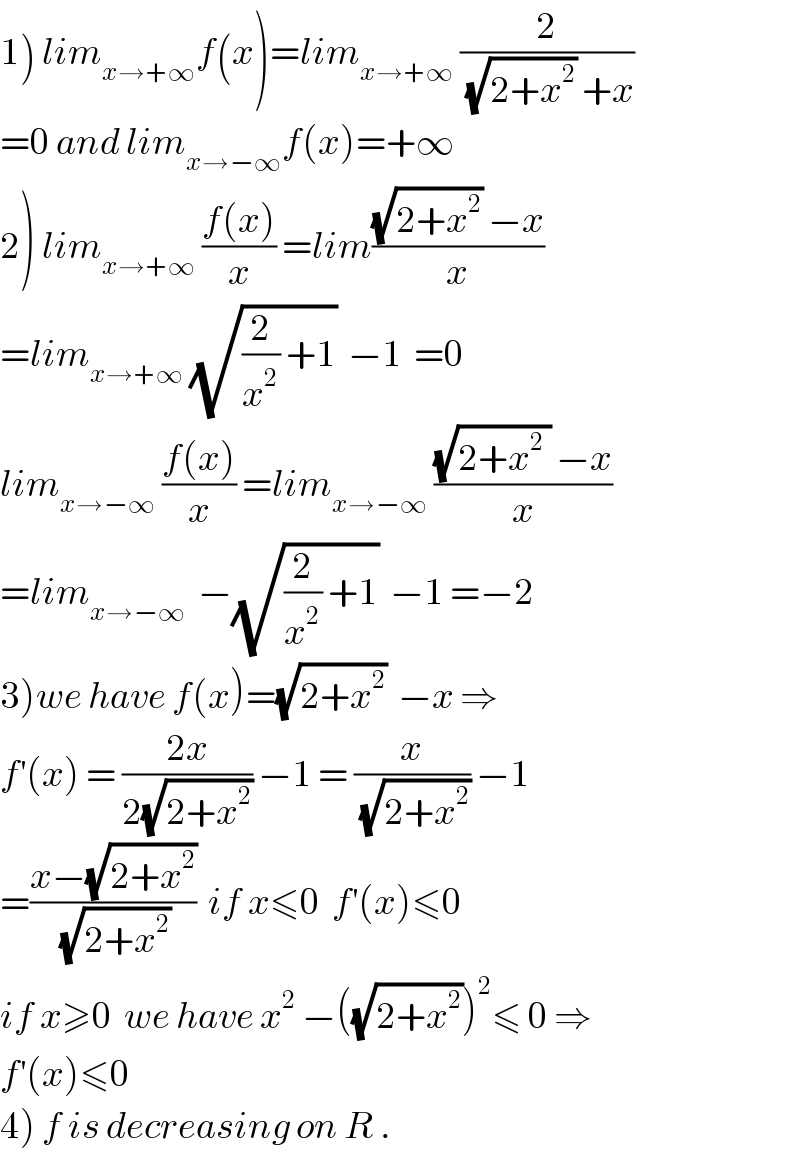
Question and Answers Forum
Previous in Relation and Functions Next in Relation and Functions
Question Number 36442 by abdo mathsup 649 cc last updated on 02/Jun/18

Commented by abdo.msup.com last updated on 05/Jun/18

Commented by abdo.msup.com last updated on 05/Jun/18

Commented by abdo.msup.com last updated on 05/Jun/18
![6) f is decreasing so f]−∞,+∞[ =]f(+∞),f(−∞)[=]0,+∞[ f is a bijection from R to ]0,+∞[ let f(x)=y ⇔ (√(2+x^2 )) −x =y ⇒ (√(2+x^2 )) =x +y ( so x+y>0)⇒ 2+x^2 =x^2 +2xy +y^2 ⇒ 2=2xy +y^2 ⇒ 2−y^2 =2xy ⇒x=((2−y^2 )/(2y)) ⇒ f^(−1) (x) = ((2−x^2 )/(2x)) and x>0](Q36805.png)
Commented by abdo.msup.com last updated on 05/Jun/18

Commented by abdo.msup.com last updated on 05/Jun/18
![7) let A= ∫_0 ^4 f(x)dx A = ∫_0 ^4 ((√(2+x^2 )) −x)dx =∫_0 ^4 (√(2+x^2 )) dx −[(x^2 /2)]_0 ^4 =∫_0 ^4 (√(2+x^2 ))dx −8 but chang.x=(√2) sh(t) give ∫_0 ^4 (√(2+x^2 ))dx=(√2) ∫_0 ^(argsh((4/(√2)))) ch(t)(√2)chtdt = 2 ∫_0 ^(argsh((4/(√2)))) ch^2 (t)dt =2 ∫_0 ^(argsh((4/(√2)))) ((1+ch(2t))/2)dt =argsh((4/(√2))) +(1/2)[sh(2t)]_0 ^(argsh((4/(√2)))) =ln( (4/(√2)) +3) +(1/2)sh(2 ln{(4/(√2)) +3)}) =ln((4/(√2)) +3) +(1/4){ ((4/(√2)) +3)^2 +((4/(√2)) +3)^(−1) } .](Q36807.png)
Commented by abdo.msup.com last updated on 05/Jun/18

